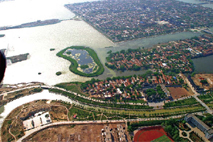| Ecological Liaocheng by the Grand Canal
By LIU GUANGHUI & YI FAN
 |
| A bird's-eye view of Liaocheng |
MULTIPLE ancient cultures met on the vast Luxi (western Shandong) Plain: agricultural culture, Yellow River culture, and the commercial culture out of the Beijing-Hangzhou Grand Canal, to name just a few. No wonder people describe Liaocheng, a vibrant city lying on this plain, as "energetic, ancient and modern."
A Long History
Located in western Shandong, and standing at the crossroads of Hebei, Shandong and Henan provinces, Liaocheng has many things to boast of: a long history, a rich cultural heritage and a great number of tourist sites. Needless to say, it also features highly developed modern commerce. The Beijing-Hangzhou Grand Canal and the Yellow River meet here, as do the north-south Beijing-Kowloon Railway and east-west Qingdao-Jinan-Handan Railway and Expressway.
The past 2,500 years have left over 400 remains of historic and cultural significance, some of them dating back to the Neolithic Age. Among them are the graveyard of Cao Zhi from the Three Kingdoms Period (220-265), Guangyue Tower from the Ming Dynasty (1368-1644), Linqing Customs Post of the Ming and Qing dynasties, and Shanxi and Shaanxi Provincial Guild Hall. The city is also the setting of several famous classical Chinese novels, including Outlaws of the Marsh, Jin Ping Mei (The Plum in the Golden Vase), and The Travelogue of Laocan.
Liaocheng has produced many talented people, among them Yin Yi, a minister of the Shang Dynasty (16th-11th century BC); Sun Bin, the well-known military strategist of the Warring States Period; Fu Yijian (1609-1655), the first scholar to win the highest academic honor in the Qing imperial examinations, who later became prime minister; and contemporary celebrities like Zhang Zizhong, Fu Sinian, Ji Xianlin and Kong Fansen.
Liaocheng is a water city in every sense, blessed with 23 small and three big rivers. The city holds the Yellow River in its bosom for 50 kilometers before reluctantly releasing it, while the Beijing-Hangzhou Grand Canal goes right through the downtown area. Dongchang Lake can be found within the city limits. This 6.3 square-kilometer body of water embraces the one-square-kilometer city of the Song Dynasty from 1,000 years ago, a unique lake in China.
An Industrial and Tourist City
Liaocheng takes pride in its high-quality wheat, organic vegetables and fruits, edible fungi, poultry farming, and processing. But the city is no longer solely a traditional agricultural place, for the modern economy has achieved rapid progress. Among its booming modern industries are machine manufacturing, nonferrous metals, textiles, pharmaceuticals, paper making, chemical industries and farm produce processing. The city is the home of many nationally and internationally famous brands. Many business giants in this city lead their fields nationwide. The Dongjiao Group, the largest producer of medicinal glue in the country, is the most prominent. As an important commercial and trading zone, Liaocheng has over 40 large wholesale markets for different goods. It is also the government's storage place for strategic commodities like grain, cotton, coal and crude oil. Finally, it serves as a hub for distributing containers nationwide.
A large number of tourist attractions make Liaocheng a fascinating tourist city as well. They include Dongchang Lake, the Grand Canal, modern theaters and city squares by the water, the Grand Canal Museum, Jingyang Ridge, the Lion Tower and Cao Zhi's graveyard. There are attractions for every taste, be it architectural, literary, historical or ecological.
October is the highlight of the year, when numerous activities turn the city into a carnival for tourists. As part of Shandong's tourist development, Liaocheng has become a place to satisfy needs of every kind, including eating, shopping, sightseeing and relaxation.
River Cruise
Most tourist sites in Liaocheng are accessible by rivers. Like pearls on a necklace, they make for a wonderful tour by water.
In boats moving on vast lakes or along zigzagging rivers, tourists find themselves overcome by fascination with the history and modernity of a city on water.
Many museums and historical sites are located on lake or river banks: Kong Fansen Museum, Fu Sinian Museum, Ming and Qing Dynasties Imperial Edicts Museum, Shanxi and Shaanxi Guide Hall, the ancient library of Haiyuan Tower, and Guangyue Tower, the oldest wooden tower in China. In the company of these historical sites are modern facilities equipped with the most advanced acoustic and lighting effects.
Liaocheng by night has a special charm. With lights shimmering on the water, faint songs drifting from the distance and water lapping against the boat, a night cruise will leave an undying memory of this ancient city of the East.
|
